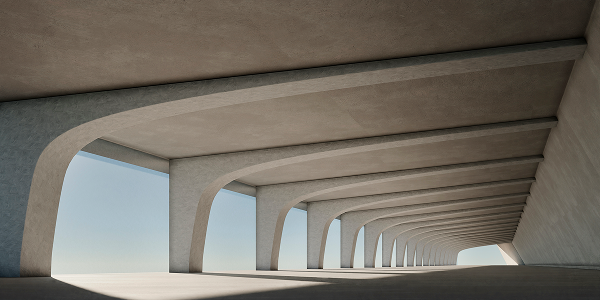Why Concrete?
Due to its role in meeting one of humanity’s most fundamental needs—shelter and protection—concrete has become the most widely used building material after the shift to settled life, and it continues to maintain this importance today. There are many reasons for this. The most fundamental reason is its durability.
For this reason, people prefer concrete in their constructions. Additionally, concrete can be produced with less energy than other materials and is highly accessible, making it a popular choice.
The History of Concrete
The first examples of concrete date back to 5,000 years ago in ancient Egypt, where clay mortar was used to build the pyramids. The Romans are credited with being the first to use cement that hardens when mixed with water. It is also known that the Chinese used binding materials during the construction of the Great Wall. Around the same time, the Turks and Persians used a strong binder known as “Horasan mortar,” which was unknown to Europeans.
The first use of ready-mix concrete in modern times occurred in Germany. They pioneered the production of ready-mix concrete in 1903 and patented the first concrete pump in 1927. The first concrete mixer was invented in 1916 by a Turkish immigrant to the United States.
In 1928, French engineer Eugene Freyssinet developed pre-stressed concrete using high-strength steel and concrete.
In 1957, the Turkish Cement Producers Association was established, followed by the Turkish Ready-Mix Concrete Association in 1988.
Since 1976, when Turkey was introduced to ready-mix concrete, it has become the third-largest concrete producer in the world, after China and the United States, with an annual production of approximately 100 million m³ of concrete. Turkey also ranks among the top countries in terms of concrete production per capita.
What Is the Difference Between Strength and Durability in Concrete?
Two of the most commonly confused properties of concrete are strength and durability. Concrete’s strength (or compressive strength) refers to its load-bearing capacity, i.e., the maximum load it can withstand without breaking. Durability, on the other hand, refers to its resistance to various physical and chemical effects and how its quality changes over time (its service life).
Does Concrete Change According to Environmental Effects?
Both in standards and in real-life applications, it is necessary to design different types of concrete according to various environmental conditions. For example, the concrete used in Ankara should not be designed the same way as concrete used in Istanbul. Likewise, the concrete for a house by the sea should be different from one built on rock. In Ankara, environmental factors like snow, ice, and freeze-thaw cycles are present, while in Istanbul, there are effects such as chlorine from the sea. Therefore, a high-quality concrete for Ankara might not be suitable for Istanbul. It is important for these designs to be made by expert engineers.
What Is the Lifespan of Concrete?
When discussing the lifespan of structures, the correct question should be, “How long should reinforced concrete last?” First, it should be noted that every structure has a specific service life, and it is not possible to define a standard timeframe for this. The factors affecting a building’s lifespan vary and are specific to the building itself.
In general, the lifespan of reinforced concrete depends on the durability of both the concrete and the steel reinforcement, especially with respect to the corrosion (rusting) of the steel within the concrete. Under normal conditions, this is approximately 50 years. This means that buildings will typically need renovation or maintenance every 50 years, but this period can be significantly shorter depending on concrete quality and environmental effects. For special projects, high-lifespan concrete with a service life of over 100 years can also be produced.
While not the only criterion, buildings that are 30+ years old can be considered for urban renewal under certain regulations.
The Role of Concrete in Building Production
Small changes in concrete production can make a significant difference in its quality. For example, the amount of cement used per cubic meter of concrete is referred to as the dosage, and there is a minimum amount required for good concrete. Using approximately 5% more cement will improve the quality of the concrete.
The most important issue is not just designing concrete for strength but also for resistance to the environmental effects it will be exposed to.
Concrete accounts for about 5-6% of building costs. In a 100 m² building, approximately 40 m³ of concrete is used (assuming a raft foundation and shear wall system). This amount may be lower for other types of structural systems. It would be incorrect to reduce construction costs to just raw material and material usage. Many other factors contribute to the cost, such as land, labor, financing, marketing, and sales. Particularly in luxury and high-end buildings, the property’s location and the materials used have a greater impact on construction costs.







